Marketing & Management: Decisions in Consumer & Competitor Markets
VerifiedAdded on 2023/04/21
|8
|1411
|154
Essay
AI Summary
This essay examines the distinctions between consumer (B2C) and competitor (B2B) markets, utilizing smartphone apps and soft drinks as examples. It explores various marketing approaches and the impact of the Product Life Cycle on strategic decisions within both market environments. The essay highlights the differences in pricing, advertising, and distribution channel decisions made by managers in each market. In B2C, rapid consumer choices and broad internet marketing are key, while B2B emphasizes long-term relationships and face-to-face marketing. Demand forecasting methods also differ, with B2C using vicarious approaches and B2B relying on demand sensing and historical data. Ultimately, the paper underscores the importance of considering factors such as market size, target audience, and product lifecycle stage in effective marketing management.
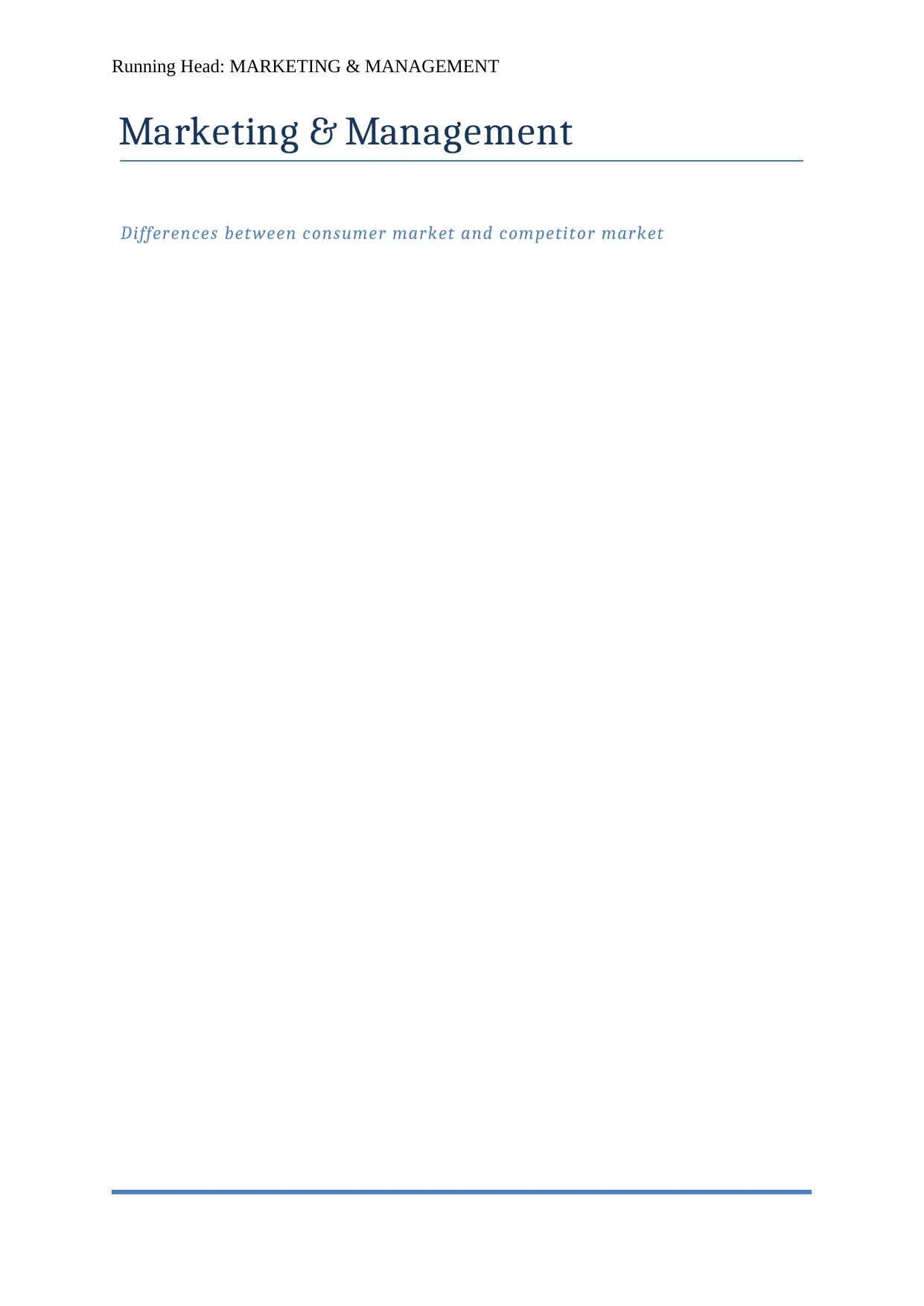
Running Head: MARKETING & MANAGEMENT
Marketing & Management
Differences between consumer market and competitor market
Marketing & Management
Differences between consumer market and competitor market
Paraphrase This Document
Need a fresh take? Get an instant paraphrase of this document with our AI Paraphraser
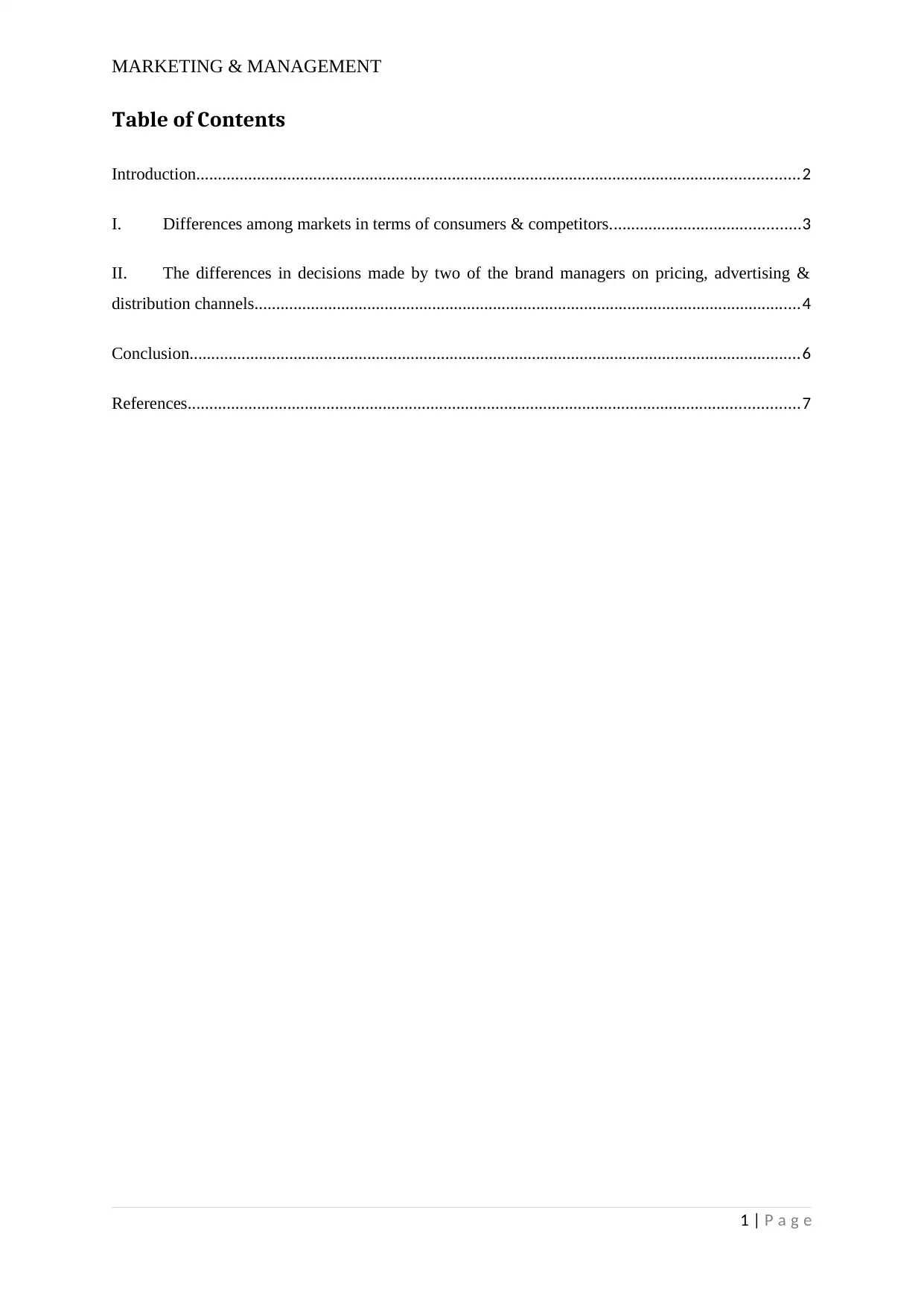
MARKETING & MANAGEMENT
Table of Contents
Introduction...........................................................................................................................................2
I. Differences among markets in terms of consumers & competitors............................................3
II. The differences in decisions made by two of the brand managers on pricing, advertising &
distribution channels..............................................................................................................................4
Conclusion.............................................................................................................................................6
References.............................................................................................................................................7
1 | P a g e
Table of Contents
Introduction...........................................................................................................................................2
I. Differences among markets in terms of consumers & competitors............................................3
II. The differences in decisions made by two of the brand managers on pricing, advertising &
distribution channels..............................................................................................................................4
Conclusion.............................................................................................................................................6
References.............................................................................................................................................7
1 | P a g e
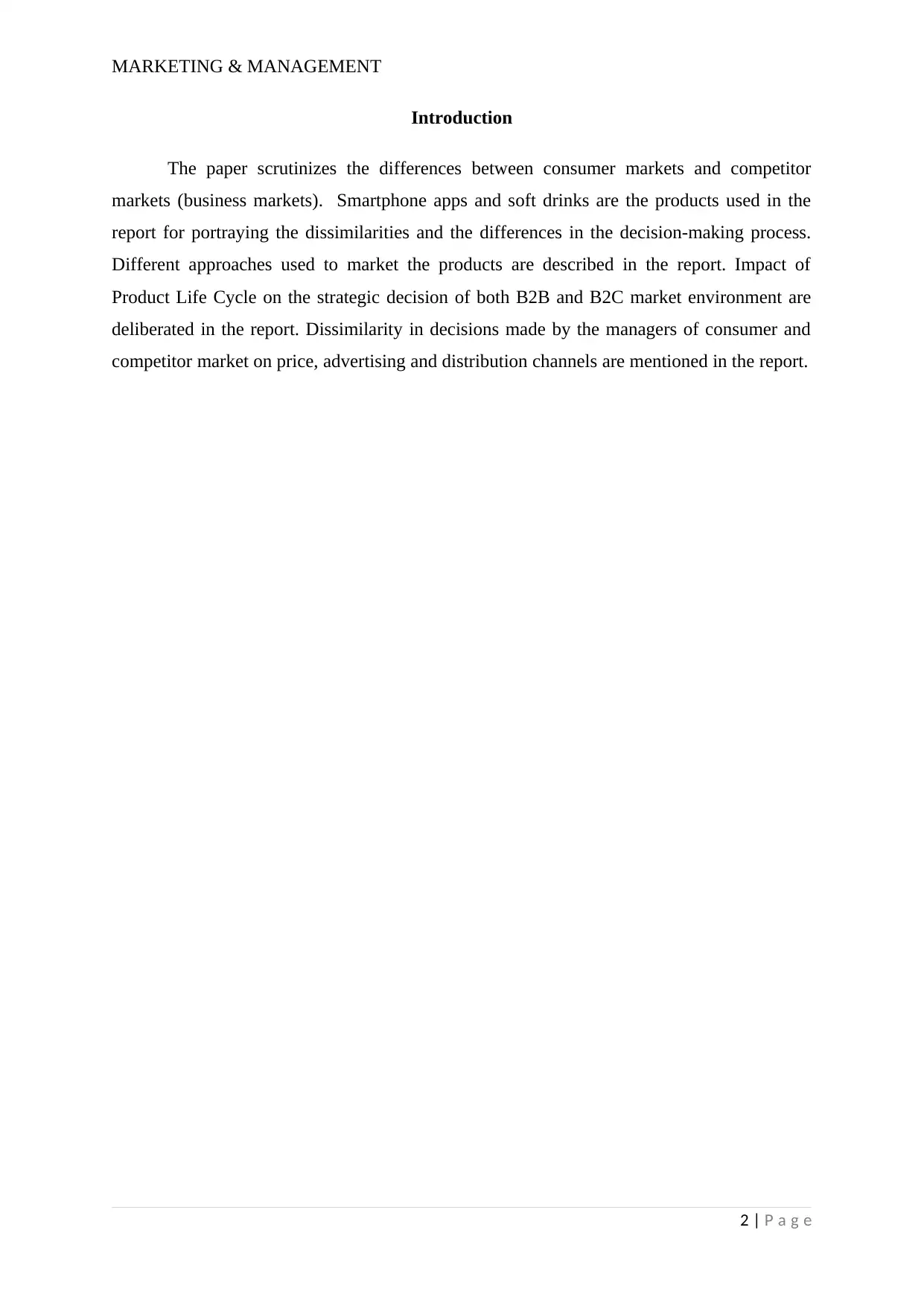
MARKETING & MANAGEMENT
Introduction
The paper scrutinizes the differences between consumer markets and competitor
markets (business markets). Smartphone apps and soft drinks are the products used in the
report for portraying the dissimilarities and the differences in the decision-making process.
Different approaches used to market the products are described in the report. Impact of
Product Life Cycle on the strategic decision of both B2B and B2C market environment are
deliberated in the report. Dissimilarity in decisions made by the managers of consumer and
competitor market on price, advertising and distribution channels are mentioned in the report.
2 | P a g e
Introduction
The paper scrutinizes the differences between consumer markets and competitor
markets (business markets). Smartphone apps and soft drinks are the products used in the
report for portraying the dissimilarities and the differences in the decision-making process.
Different approaches used to market the products are described in the report. Impact of
Product Life Cycle on the strategic decision of both B2B and B2C market environment are
deliberated in the report. Dissimilarity in decisions made by the managers of consumer and
competitor market on price, advertising and distribution channels are mentioned in the report.
2 | P a g e
⊘ This is a preview!⊘
Do you want full access?
Subscribe today to unlock all pages.

Trusted by 1+ million students worldwide
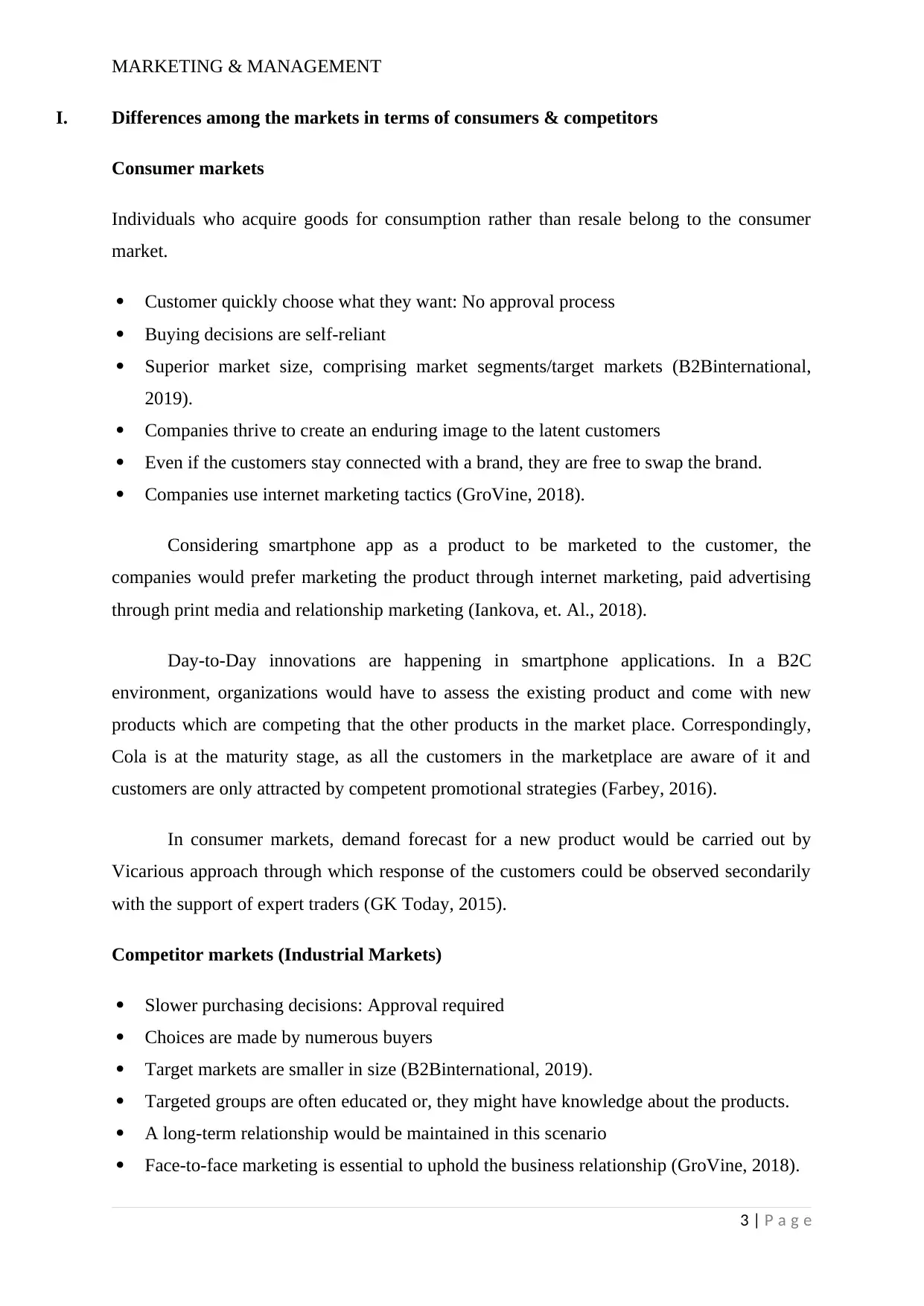
MARKETING & MANAGEMENT
I. Differences among the markets in terms of consumers & competitors
Consumer markets
Individuals who acquire goods for consumption rather than resale belong to the consumer
market.
Customer quickly choose what they want: No approval process
Buying decisions are self-reliant
Superior market size, comprising market segments/target markets (B2Binternational,
2019).
Companies thrive to create an enduring image to the latent customers
Even if the customers stay connected with a brand, they are free to swap the brand.
Companies use internet marketing tactics (GroVine, 2018).
Considering smartphone app as a product to be marketed to the customer, the
companies would prefer marketing the product through internet marketing, paid advertising
through print media and relationship marketing (Iankova, et. Al., 2018).
Day-to-Day innovations are happening in smartphone applications. In a B2C
environment, organizations would have to assess the existing product and come with new
products which are competing that the other products in the market place. Correspondingly,
Cola is at the maturity stage, as all the customers in the marketplace are aware of it and
customers are only attracted by competent promotional strategies (Farbey, 2016).
In consumer markets, demand forecast for a new product would be carried out by
Vicarious approach through which response of the customers could be observed secondarily
with the support of expert traders (GK Today, 2015).
Competitor markets (Industrial Markets)
Slower purchasing decisions: Approval required
Choices are made by numerous buyers
Target markets are smaller in size (B2Binternational, 2019).
Targeted groups are often educated or, they might have knowledge about the products.
A long-term relationship would be maintained in this scenario
Face-to-face marketing is essential to uphold the business relationship (GroVine, 2018).
3 | P a g e
I. Differences among the markets in terms of consumers & competitors
Consumer markets
Individuals who acquire goods for consumption rather than resale belong to the consumer
market.
Customer quickly choose what they want: No approval process
Buying decisions are self-reliant
Superior market size, comprising market segments/target markets (B2Binternational,
2019).
Companies thrive to create an enduring image to the latent customers
Even if the customers stay connected with a brand, they are free to swap the brand.
Companies use internet marketing tactics (GroVine, 2018).
Considering smartphone app as a product to be marketed to the customer, the
companies would prefer marketing the product through internet marketing, paid advertising
through print media and relationship marketing (Iankova, et. Al., 2018).
Day-to-Day innovations are happening in smartphone applications. In a B2C
environment, organizations would have to assess the existing product and come with new
products which are competing that the other products in the market place. Correspondingly,
Cola is at the maturity stage, as all the customers in the marketplace are aware of it and
customers are only attracted by competent promotional strategies (Farbey, 2016).
In consumer markets, demand forecast for a new product would be carried out by
Vicarious approach through which response of the customers could be observed secondarily
with the support of expert traders (GK Today, 2015).
Competitor markets (Industrial Markets)
Slower purchasing decisions: Approval required
Choices are made by numerous buyers
Target markets are smaller in size (B2Binternational, 2019).
Targeted groups are often educated or, they might have knowledge about the products.
A long-term relationship would be maintained in this scenario
Face-to-face marketing is essential to uphold the business relationship (GroVine, 2018).
3 | P a g e
Paraphrase This Document
Need a fresh take? Get an instant paraphrase of this document with our AI Paraphraser
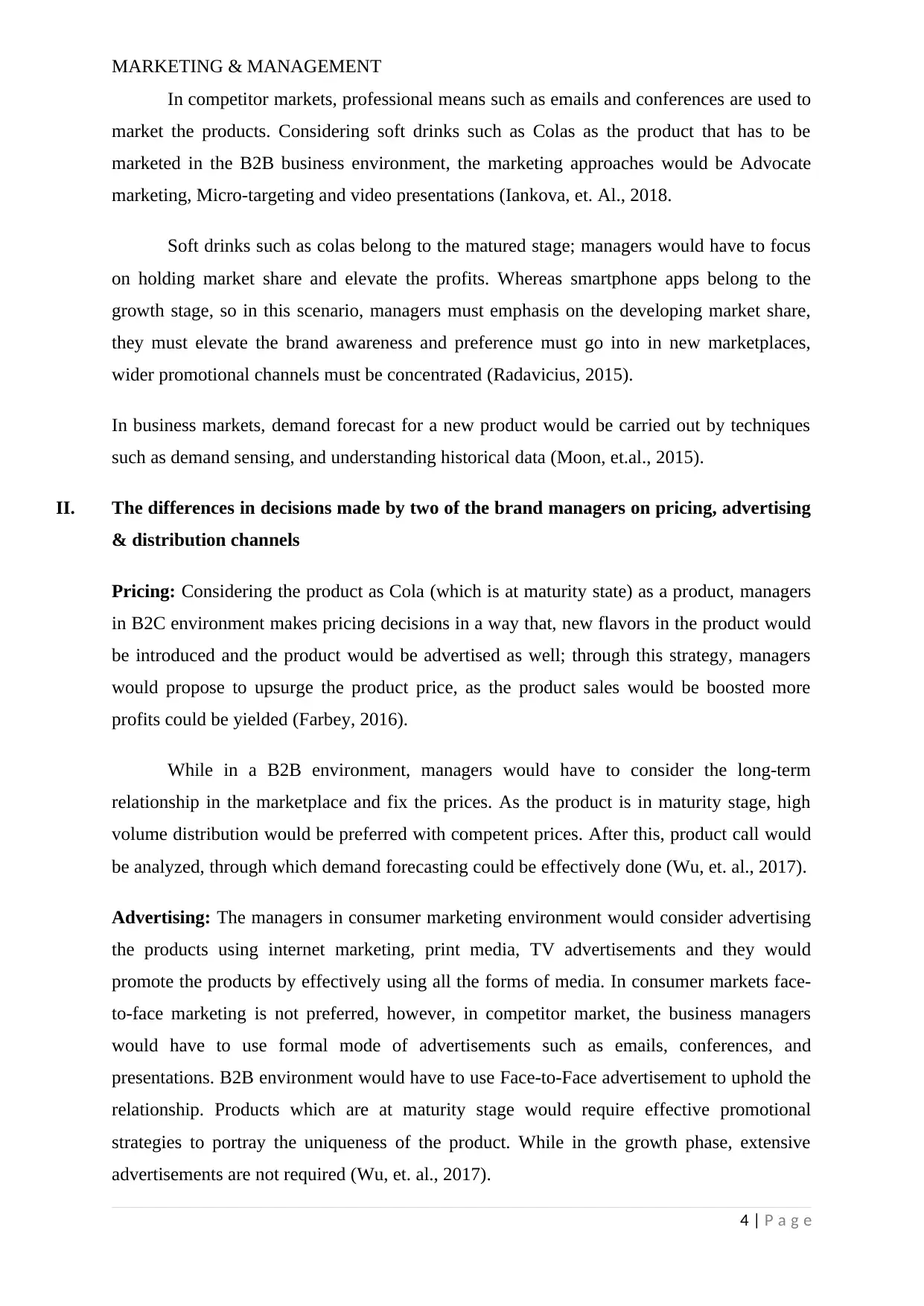
MARKETING & MANAGEMENT
In competitor markets, professional means such as emails and conferences are used to
market the products. Considering soft drinks such as Colas as the product that has to be
marketed in the B2B business environment, the marketing approaches would be Advocate
marketing, Micro-targeting and video presentations (Iankova, et. Al., 2018.
Soft drinks such as colas belong to the matured stage; managers would have to focus
on holding market share and elevate the profits. Whereas smartphone apps belong to the
growth stage, so in this scenario, managers must emphasis on the developing market share,
they must elevate the brand awareness and preference must go into in new marketplaces,
wider promotional channels must be concentrated (Radavicius, 2015).
In business markets, demand forecast for a new product would be carried out by techniques
such as demand sensing, and understanding historical data (Moon, et.al., 2015).
II. The differences in decisions made by two of the brand managers on pricing, advertising
& distribution channels
Pricing: Considering the product as Cola (which is at maturity state) as a product, managers
in B2C environment makes pricing decisions in a way that, new flavors in the product would
be introduced and the product would be advertised as well; through this strategy, managers
would propose to upsurge the product price, as the product sales would be boosted more
profits could be yielded (Farbey, 2016).
While in a B2B environment, managers would have to consider the long-term
relationship in the marketplace and fix the prices. As the product is in maturity stage, high
volume distribution would be preferred with competent prices. After this, product call would
be analyzed, through which demand forecasting could be effectively done (Wu, et. al., 2017).
Advertising: The managers in consumer marketing environment would consider advertising
the products using internet marketing, print media, TV advertisements and they would
promote the products by effectively using all the forms of media. In consumer markets face-
to-face marketing is not preferred, however, in competitor market, the business managers
would have to use formal mode of advertisements such as emails, conferences, and
presentations. B2B environment would have to use Face-to-Face advertisement to uphold the
relationship. Products which are at maturity stage would require effective promotional
strategies to portray the uniqueness of the product. While in the growth phase, extensive
advertisements are not required (Wu, et. al., 2017).
4 | P a g e
In competitor markets, professional means such as emails and conferences are used to
market the products. Considering soft drinks such as Colas as the product that has to be
marketed in the B2B business environment, the marketing approaches would be Advocate
marketing, Micro-targeting and video presentations (Iankova, et. Al., 2018.
Soft drinks such as colas belong to the matured stage; managers would have to focus
on holding market share and elevate the profits. Whereas smartphone apps belong to the
growth stage, so in this scenario, managers must emphasis on the developing market share,
they must elevate the brand awareness and preference must go into in new marketplaces,
wider promotional channels must be concentrated (Radavicius, 2015).
In business markets, demand forecast for a new product would be carried out by techniques
such as demand sensing, and understanding historical data (Moon, et.al., 2015).
II. The differences in decisions made by two of the brand managers on pricing, advertising
& distribution channels
Pricing: Considering the product as Cola (which is at maturity state) as a product, managers
in B2C environment makes pricing decisions in a way that, new flavors in the product would
be introduced and the product would be advertised as well; through this strategy, managers
would propose to upsurge the product price, as the product sales would be boosted more
profits could be yielded (Farbey, 2016).
While in a B2B environment, managers would have to consider the long-term
relationship in the marketplace and fix the prices. As the product is in maturity stage, high
volume distribution would be preferred with competent prices. After this, product call would
be analyzed, through which demand forecasting could be effectively done (Wu, et. al., 2017).
Advertising: The managers in consumer marketing environment would consider advertising
the products using internet marketing, print media, TV advertisements and they would
promote the products by effectively using all the forms of media. In consumer markets face-
to-face marketing is not preferred, however, in competitor market, the business managers
would have to use formal mode of advertisements such as emails, conferences, and
presentations. B2B environment would have to use Face-to-Face advertisement to uphold the
relationship. Products which are at maturity stage would require effective promotional
strategies to portray the uniqueness of the product. While in the growth phase, extensive
advertisements are not required (Wu, et. al., 2017).
4 | P a g e
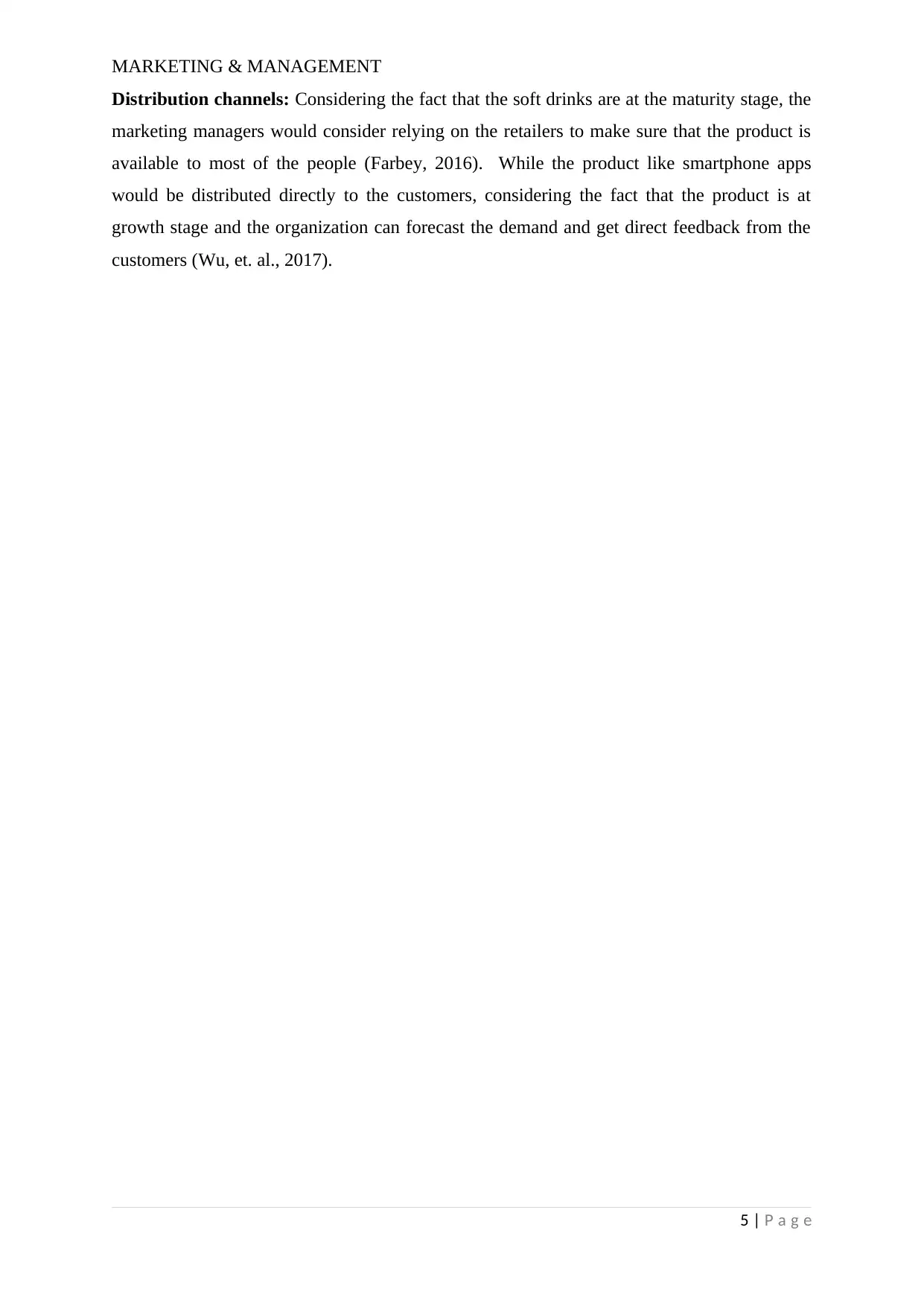
MARKETING & MANAGEMENT
Distribution channels: Considering the fact that the soft drinks are at the maturity stage, the
marketing managers would consider relying on the retailers to make sure that the product is
available to most of the people (Farbey, 2016). While the product like smartphone apps
would be distributed directly to the customers, considering the fact that the product is at
growth stage and the organization can forecast the demand and get direct feedback from the
customers (Wu, et. al., 2017).
5 | P a g e
Distribution channels: Considering the fact that the soft drinks are at the maturity stage, the
marketing managers would consider relying on the retailers to make sure that the product is
available to most of the people (Farbey, 2016). While the product like smartphone apps
would be distributed directly to the customers, considering the fact that the product is at
growth stage and the organization can forecast the demand and get direct feedback from the
customers (Wu, et. al., 2017).
5 | P a g e
⊘ This is a preview!⊘
Do you want full access?
Subscribe today to unlock all pages.

Trusted by 1+ million students worldwide
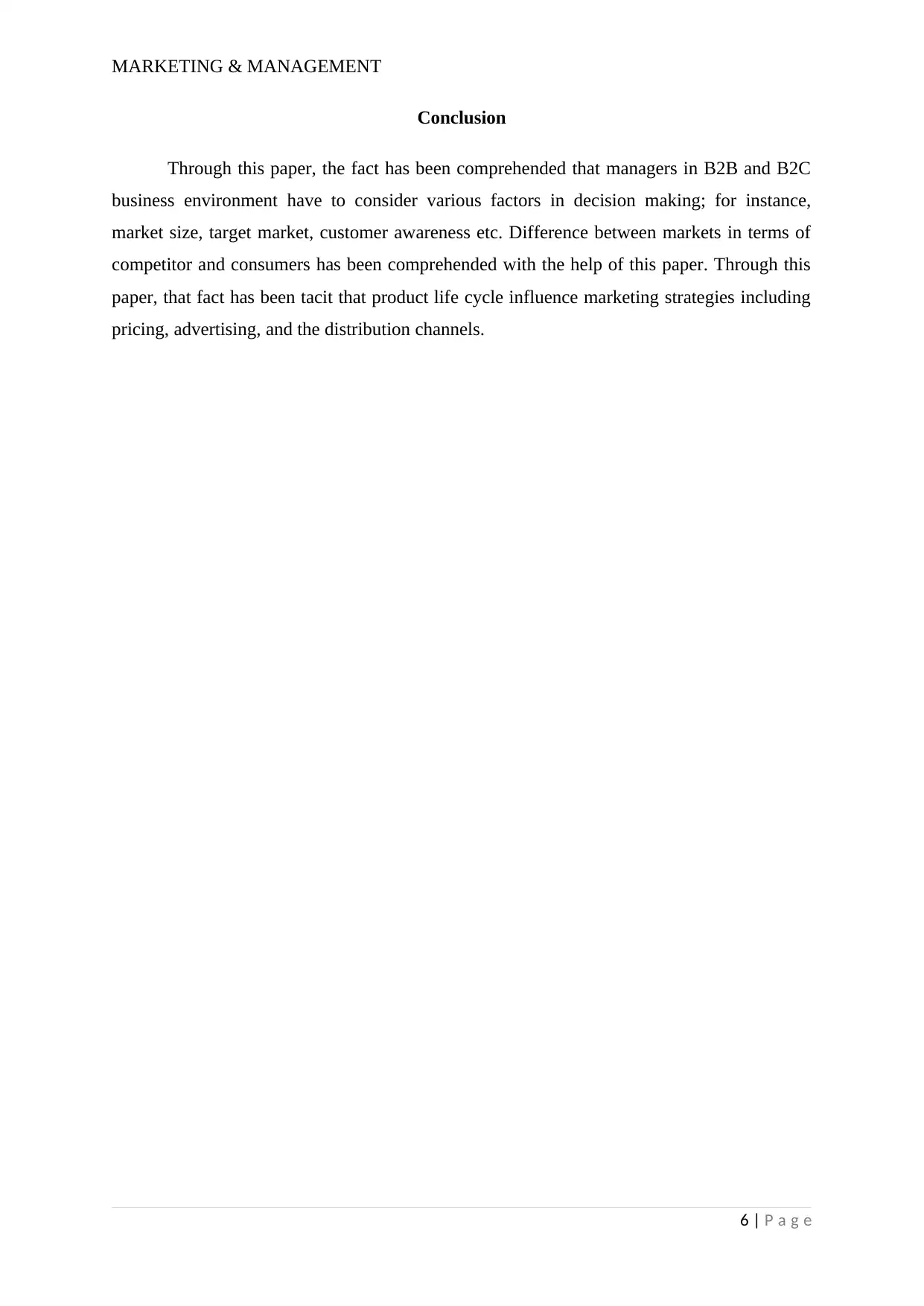
MARKETING & MANAGEMENT
Conclusion
Through this paper, the fact has been comprehended that managers in B2B and B2C
business environment have to consider various factors in decision making; for instance,
market size, target market, customer awareness etc. Difference between markets in terms of
competitor and consumers has been comprehended with the help of this paper. Through this
paper, that fact has been tacit that product life cycle influence marketing strategies including
pricing, advertising, and the distribution channels.
6 | P a g e
Conclusion
Through this paper, the fact has been comprehended that managers in B2B and B2C
business environment have to consider various factors in decision making; for instance,
market size, target market, customer awareness etc. Difference between markets in terms of
competitor and consumers has been comprehended with the help of this paper. Through this
paper, that fact has been tacit that product life cycle influence marketing strategies including
pricing, advertising, and the distribution channels.
6 | P a g e
Paraphrase This Document
Need a fresh take? Get an instant paraphrase of this document with our AI Paraphraser
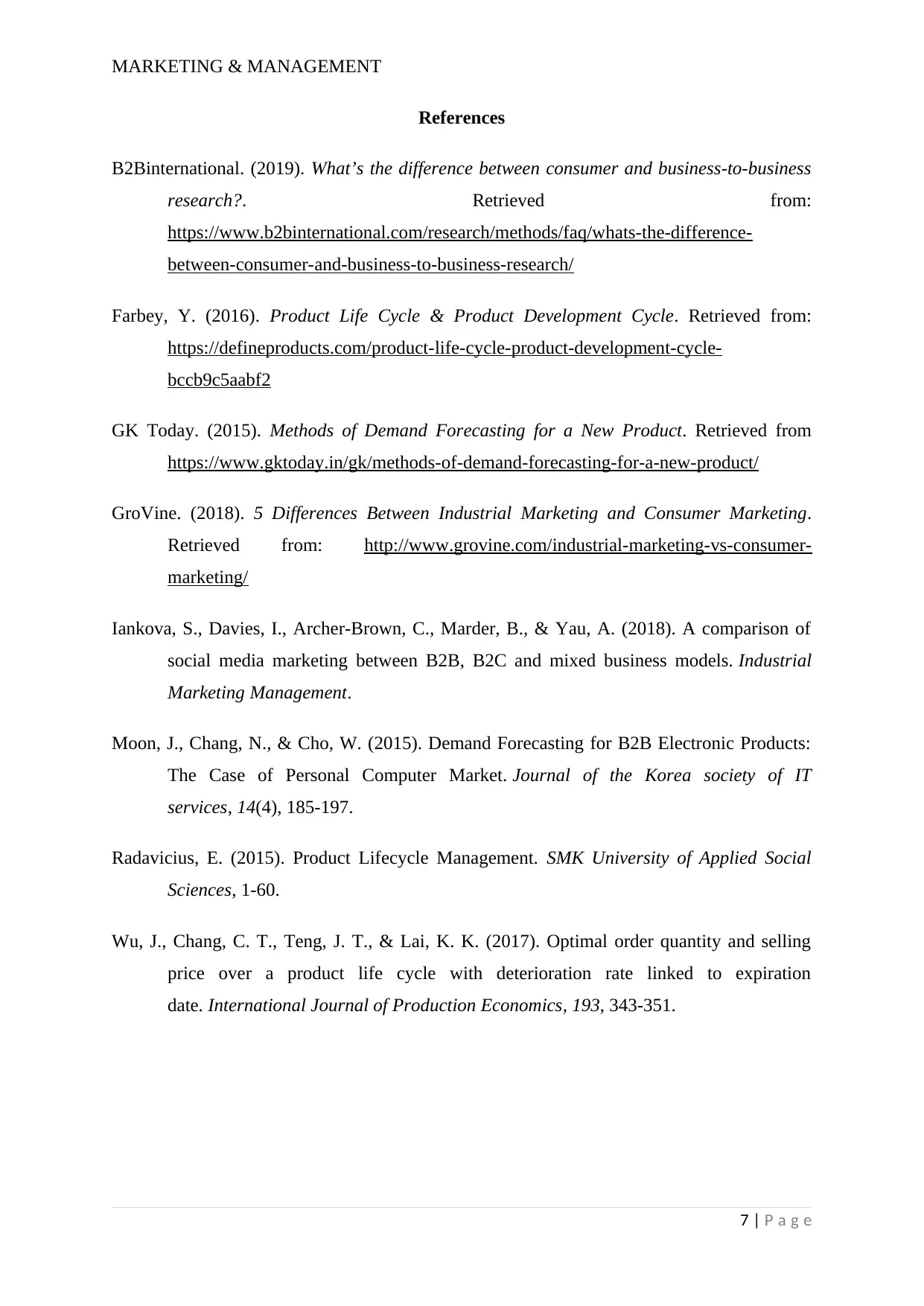
MARKETING & MANAGEMENT
References
B2Binternational. (2019). What’s the difference between consumer and business-to-business
research?. Retrieved from:
https://www.b2binternational.com/research/methods/faq/whats-the-difference-
between-consumer-and-business-to-business-research/
Farbey, Y. (2016). Product Life Cycle & Product Development Cycle. Retrieved from:
https://defineproducts.com/product-life-cycle-product-development-cycle-
bccb9c5aabf2
GK Today. (2015). Methods of Demand Forecasting for a New Product. Retrieved from
https://www.gktoday.in/gk/methods-of-demand-forecasting-for-a-new-product/
GroVine. (2018). 5 Differences Between Industrial Marketing and Consumer Marketing.
Retrieved from: http://www.grovine.com/industrial-marketing-vs-consumer-
marketing/
Iankova, S., Davies, I., Archer-Brown, C., Marder, B., & Yau, A. (2018). A comparison of
social media marketing between B2B, B2C and mixed business models. Industrial
Marketing Management.
Moon, J., Chang, N., & Cho, W. (2015). Demand Forecasting for B2B Electronic Products:
The Case of Personal Computer Market. Journal of the Korea society of IT
services, 14(4), 185-197.
Radavicius, E. (2015). Product Lifecycle Management. SMK University of Applied Social
Sciences, 1-60.
Wu, J., Chang, C. T., Teng, J. T., & Lai, K. K. (2017). Optimal order quantity and selling
price over a product life cycle with deterioration rate linked to expiration
date. International Journal of Production Economics, 193, 343-351.
7 | P a g e
References
B2Binternational. (2019). What’s the difference between consumer and business-to-business
research?. Retrieved from:
https://www.b2binternational.com/research/methods/faq/whats-the-difference-
between-consumer-and-business-to-business-research/
Farbey, Y. (2016). Product Life Cycle & Product Development Cycle. Retrieved from:
https://defineproducts.com/product-life-cycle-product-development-cycle-
bccb9c5aabf2
GK Today. (2015). Methods of Demand Forecasting for a New Product. Retrieved from
https://www.gktoday.in/gk/methods-of-demand-forecasting-for-a-new-product/
GroVine. (2018). 5 Differences Between Industrial Marketing and Consumer Marketing.
Retrieved from: http://www.grovine.com/industrial-marketing-vs-consumer-
marketing/
Iankova, S., Davies, I., Archer-Brown, C., Marder, B., & Yau, A. (2018). A comparison of
social media marketing between B2B, B2C and mixed business models. Industrial
Marketing Management.
Moon, J., Chang, N., & Cho, W. (2015). Demand Forecasting for B2B Electronic Products:
The Case of Personal Computer Market. Journal of the Korea society of IT
services, 14(4), 185-197.
Radavicius, E. (2015). Product Lifecycle Management. SMK University of Applied Social
Sciences, 1-60.
Wu, J., Chang, C. T., Teng, J. T., & Lai, K. K. (2017). Optimal order quantity and selling
price over a product life cycle with deterioration rate linked to expiration
date. International Journal of Production Economics, 193, 343-351.
7 | P a g e
1 out of 8
Related Documents
Your All-in-One AI-Powered Toolkit for Academic Success.
+13062052269
info@desklib.com
Available 24*7 on WhatsApp / Email
![[object Object]](/_next/static/media/star-bottom.7253800d.svg)
Unlock your academic potential
Copyright © 2020–2025 A2Z Services. All Rights Reserved. Developed and managed by ZUCOL.




